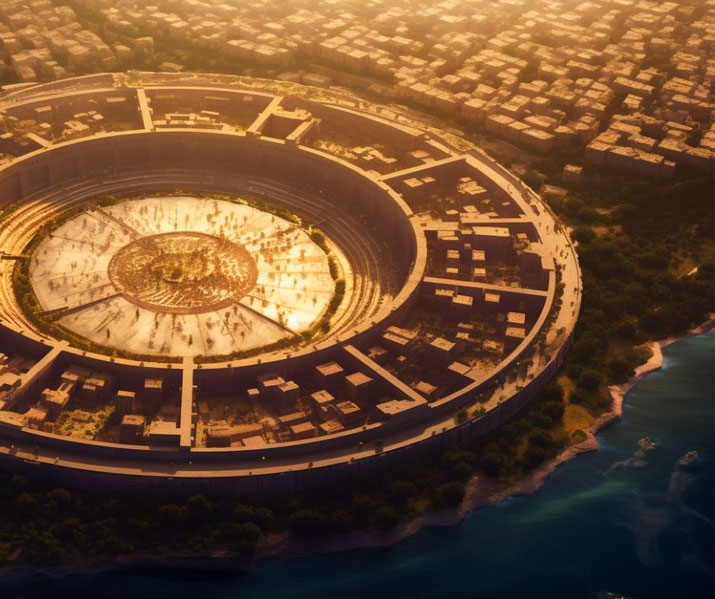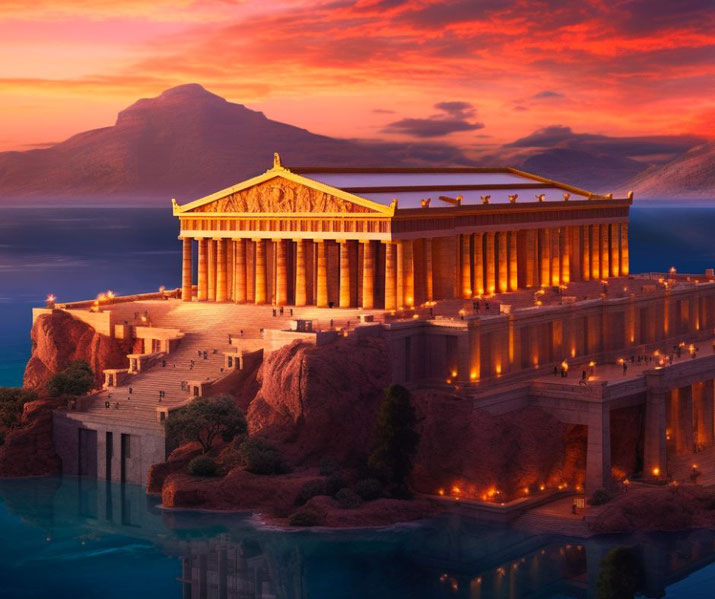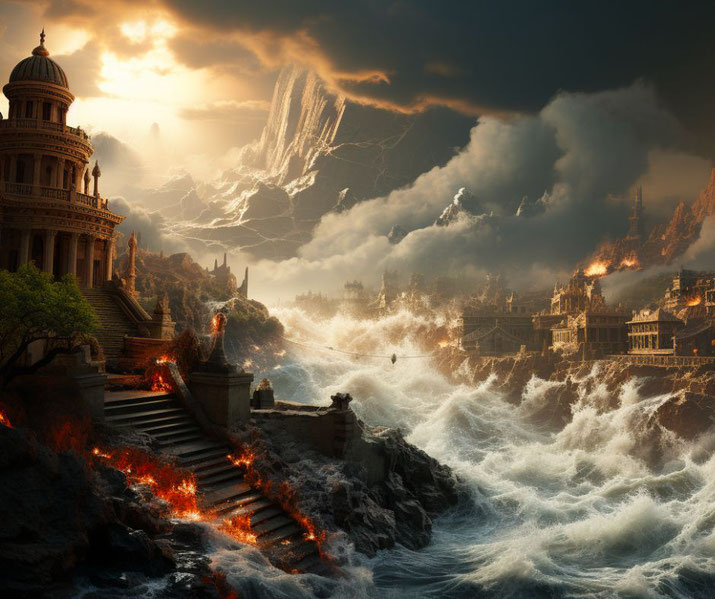Was Atlantis real? Everything we currently know about this mysterious ancient city.

Atlantis, the fabled lost city, has long been a source of fascination, drawing historians, adventurers, and dreamers into fierce arguments about its existence.
Its story, based upon ancient texts and modern speculations, walks the fine line between myth and reality, challenging our conventional understanding of the past.
But what truths lie behind the legend of this sunken empire?
Where might it have been located?
And why, after all these centuries, does the mystery of Atlantis continue to captivate us?
The very first historical evidence of Atlantis
The story of Atlantis can be traced back to two specific works by the ancient Greek philosopher Plato: the "Timaeus" and the "Critias."
Written around 360 BCE, these dialogues are our primary sources of information about the fabled city.
In "Timaeus," Plato describes a conversation between Socrates, Timaeus, Hermocrates, and Critias.
It is Critias who recounts the tale of Atlantis, claiming that it was passed down to him through his ancestors from the Athenian lawgiver Solon.
Solon, during his travels to Egypt around 590 BCE, supposedly learned of Atlantis from Egyptian priests in the city of Sais.
They described a great civilization that existed approximately 9,000 years before their time, making Atlantis a society that would have thrived around 9,600 BCE.
In the "Critias" dialogue, Plato delves deeper into the description of Atlantis, detailing its geography, governance, and eventual downfall.
The island, larger than Asia and Libya combined, was said to be located beyond the "Pillars of Hercules" (commonly identified as the modern-day Strait of Gibraltar).
The Atlanteans were portrayed as a formidable naval power, conquering parts of Europe and Africa before being repelled by the ancient Athenians.
However, their decline was swift. In a single day and night, a series of catastrophic events led to the submersion of Atlantis, leaving it lost to the depths of the sea.

The physical description of Atlantis
Plato's descriptions of Atlantis offer a vivid portrayal of its geography and layout.
The heart of Atlantis was a central city surrounded by concentric rings of water and land.
These rings, alternating between wide circles of sea and land, were connected by tunnels wide enough to accommodate ships, allowing for easy naval movement.

The central city, a hub of activity and governance, was situated on a plain and surrounded by mountains that descended toward the sea.
This plain was described as being 3,000 stadia in length and 2,000 stadia in width, irrigated by a network of canals.
The mountains sheltered the city and were renowned for their size and beauty, with the largest of them surpassing any mountains known to the ancient Greeks.
At the very center of the concentric circles stood a hill, upon which a palace was built for the first king of Atlantis, Atlas, from whom the island derived its name.
Surrounding this hill were walls made of stone – red, white, and black – quarried from the nearby mountains and valleys.
The walls were adorned with precious metals, reflecting the island's immense wealth.
Beyond the central city, the rest of Atlantis was divided into ten regions, each governed by a king.
These regions were rich in resources, with abundant minerals, flora, and fauna.
The soil was fertile, yielding two crops a year, and the island was rich in timber, exotic wildlife, and natural springs.
Who lived in Atlantis?
The society and culture of Atlantis, as depicted by Plato, showcased a civilization of great sophistication and power.
At its zenith, Atlantis was a beacon of prosperity, innovation, and governance, with a societal structure that was both hierarchical and collaborative.
The political structure of Atlantis was organized around a confederation of kings.
Ten in total, these rulers were descendants of the island's divine founders, with each king governing one of the ten regions of Atlantis.
The central authority was vested in the first king, Atlas, after whom the island was named.
These kings would convene in the central city to discuss matters of law, pass judgments, and deliberate on issues of war and peace.
Their decisions were binding, and they swore oaths to uphold the island's laws and traditions, emphasizing the unity and shared responsibility of their rule.
Atlantean culture was deeply rooted in both its maritime prowess and its spiritual beliefs.
As a naval superpower, Atlantis dominated the seas, establishing trade routes and exerting influence over vast territories.
The island's inhabitants worshipped a pantheon of gods, with Poseidon, the god of the sea, at its helm.

However, as time progressed, the moral fabric of Atlantean society began to fray.
Plato describes a decline in the virtue and righteousness of the Atlanteans. Over generations, the divine portion of their lineage diluted, and with it, their noble qualities.
They became greedy, power-hungry, and corrupt, leading to internal conflicts and external aggressions.
How was Atlantis destroyed?
According to Plato's account, the destruction of Atlantis was both swift and devastating.
The once-majestic civilization, which had thrived for generations, met its end in a series of catastrophic events that spanned a single day and night.
While the exact cause of this calamity is not detailed explicitly, the narrative suggests a combination of natural disasters, possibly including earthquakes and floods, that led to the island's submersion beneath the sea.
This rapid descent into the ocean's depths rendered Atlantis inaccessible and invisible to the world, leaving behind only tales of its former glory.

The real location of Atlantis
While Plato's account is the primary source of information about this lost civilization, the lack of concrete evidence and the tantalizing nature of the tale have led many to propose various hypotheses about its existence and location.
One of the most debated topics is the actual location of Atlantis. Some theories suggest that it was located in the Mediterranean, pointing to places like Santorini, which experienced a massive volcanic eruption around 1600 BCE.
This eruption and the subsequent tsunami could have been the catastrophic events that led to the sinking of a once-thriving civilization, drawing parallels with Plato's account.
The island of Santorini, known in ancient times as Thera, has been a focal point for many researchers.
The massive volcanic eruption that took place there around 1600 BCE led to the collapse of the Minoan civilization, and some believe it could have been the inspiration behind Plato's tale.
Excavations in the region have uncovered remnants of an advanced civilization, with intricate architecture and artifacts, but a direct link to Atlantis remains elusive.
Another popular theory posits that Atlantis was in the Americas, specifically in the Caribbean or around the Bahamas.
The discovery of the Bimini Road, a submerged rock formation, in the 1960s sparked excitement among Atlantis enthusiasts.
Some speculated that these linear stone structures could be remnants of the lost city.
However, geological studies have since suggested that these formations are naturally occurring and not man-made.
The idea that Atlantis might be located in Antarctica has also gained traction among some researchers.
They suggest that the continent was once ice-free and home to an advanced civilization.
The rapid freezing and shifting ice caps could have submerged the entire city, preserving it beneath layers of ice.
In recent years, satellite imagery and advanced scanning technologies have opened new avenues for exploration.
Some researchers have utilized these tools to identify submerged structures or anomalies on the ocean floor that could hint at ancient settlements.
Areas off the coast of Spain, near the Strait of Gibraltar, have been of particular interest, given Plato's reference to Atlantis being beyond the "Pillars of Hercules."
Despite these efforts, definitive evidence of Atlantis remains elusive.
Difficulties facing historians and archaeologists
While the tale of Atlantis has captivated imaginations for centuries, it has not been without its skeptics and critics.
Many scholars and historians believe that the story of Atlantis, as presented by Plato, should not be taken as a literal historical account but rather as a philosophical allegory or parable.
One of the primary criticisms revolves around the lack of contemporary records or mentions of Atlantis outside of Plato's writings.
Given the purported size, influence, and power of the Atlantean civilization, it's surprising that no other ancient texts or records, whether Greek or from neighboring civilizations, make any reference to such a dominant empire.
This absence of corroborative evidence has led many to question the veracity of Plato's account.
Another point of skepticism is the timeline presented by Plato. According to his writings, Atlantis existed around 9,000 years before his time, placing the civilization around 11,000 years ago from the present day.
This timeline predates many known ancient civilizations and challenges our current understanding of human development and societal progression during that era.
Additionally, some scholars argue that the detailed and specific nature of Plato's account, especially regarding measurements, geography, and societal structures, is more indicative of a fictional narrative than a historical recounting.
They suggest that Plato might have used the story of Atlantis as a means to convey philosophical ideas about governance, morality, and the dangers of hubris, rather than to document a genuine historical event.
Lastly, the vast array of proposed locations for Atlantis, ranging from the Mediterranean to the Caribbean and even Antarctica, has further fueled skepticism.
The sheer diversity of these theories, often based on tenuous evidence, has led many to view the search for Atlantis as more of a romantic endeavor than a serious archaeological or historical pursuit.
What do you need help with?
Download ready-to-use digital learning resources
Copyright © History Skills 2014-2024.
Contact via email
With the exception of links to external sites, some historical sources and extracts from specific publications, all content on this website is copyrighted by History Skills. This content may not be copied, republished or redistributed without written permission from the website creator. Please use the Contact page to obtain relevant permission.





